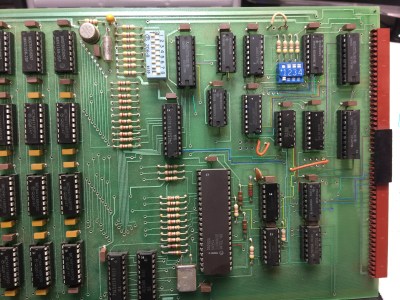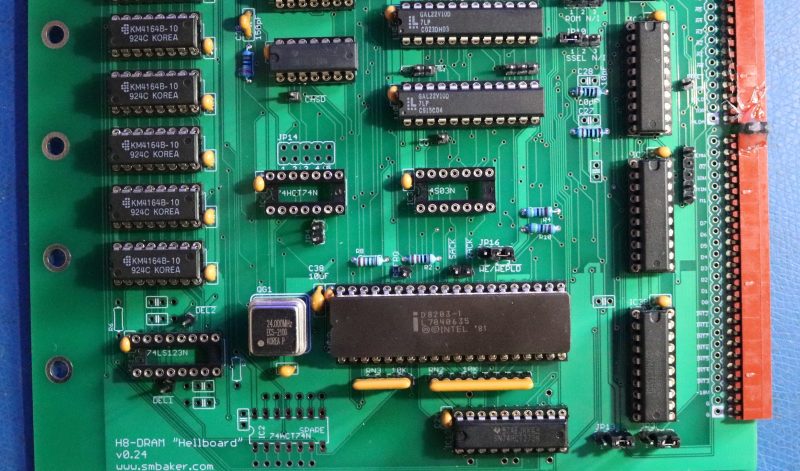Ask anyone to name a first-generation home computer from the 1970s, and they’ll probably mention the likes of the Altair 8800 and IMSAI 8080. But those iconic machines weren’t the only options available to hobbyists back in the day: Heathkit, famous for its extensive range of electronic devices sold in kit form, jumped on the microcomputer bandwagon with their H8. Though it always remained a bit of an obscure machine, several dedicated enthusiasts kept making H8-compatible hardware and software long after the computer itself went out of production. That tradition continues in 2023, with [Scott M. Baker] producing a brand-new DRAM board that’s compatible with any version of the H8.
Although the Heathkit H8 was designed around the Intel 8080 processor, it could also be equipped with a Z80. [Scott] had built an 8085 based CPU board as well, meaning that any other hardware he developed for the H8 had to support these three processors. For something as timing-critical as a memory board, this turned out to be way harder than he’d expected.
First off, he had already made things difficult for himself by choosing DRAM rather than the simpler SRAM. Whereas SRAM chips can be more or less directly hooked up to the CPU’s address and data buses, a DRAM setup needs refresh circuitry to ensure the data doesn’t leak out of the chips’ internal capacitors. [Scott] decided to use the classic D8203 DRAM controller to do that for him — a solution that was pretty common back in the day.
Getting the timing right for all signals between the CPU and the DRAM controller was not at all trivial, however. The main problem was with two signals, called /SACK and /XACK, which were used to pause memory access during refresh cycles. Depending on which CPU was on the other side, these signals apparently had to be combined with other signals, stored in a flip-flop or delayed by a cycle or two in order to align with the processor’s internal logic. None of this seemed to work reliably, so [Scott] looked elsewhere for inspiration.

He found this on eBay, where a few vintage H8-compatible DRAM boards were for sale. Although [Scott] didn’t manage to win the auction, the eventual buyer was kind enough to snap some high-resolution pictures of the board which enabled him to reverse-engineer the circuit. The board used the similar D8202 DRAM controller and came with logic that generated the proper signals to interface with the 8080 and 8085 CPUs. For the Z80, [Scott] dived into the documentation for Heathkit’s Z80 option and found a schematic with a few logic gates that would satisfy the Zilog chip as well.
[Scott] combined both of these solutions on a beautiful 1980s-style printed circuit board, with a bunch of 7400 series logic gates and even two GAL22V10 programmable logic devices. With full documentation and Gerber files available on the project’s GitHub page, Heathkit H8 owners can now get their own brand-new memory board — in kit form, as a Heathkit should be.
There are several enthusiasts keeping the various Heathkit computer models up and running, and even producing completely new ones. The Heath Company also still exists, selling electronic kits to this day.
Thanks for the tip, [Adrian]!















I remember those heathkits. Like the Edmund Scientific caatalog of that era, the Heathkit catalog was nerd porn. But i also had a paper route budget. Once i got a job that paid real money, I chose a 75 Firebird. My first computer was the ZX81 kit version though.
To the article, I didn’t realize that the H8 had various process options, though that seem fairly related.
Do these computers need DRAM for video or something, like an Apple II? There are single DIP 64K x 8 SRAM chips for a couple dollars. I use them in AIM-65, Ohio Scientific Challengers, Rockwell System-65, various early CPM S-100 buss etc. to get full RAM with lower power and very little space. I got a tube of these off eBay a couple years ago, CYPRESS CY7C185-15VC SRAM.
I think Scott likes period correct parts.
I also replace the monster transformers and caps with a little switcher from Meanwell or similar. I keep the original parts and after swapping the systems can be carried easily. Boxes like the IMSAI 8080 are ludicrously heavy in original form.
>D8203 DRAM controller, 9 TTL chips, two GALs
and the original ebay one was D8202 and 17 TTLs :o
For comparison here is Amiga 16bit fast ram controller in 12 TTLs http://amigaprj.blogspot.com/2013/05/amiga-fast-ram-expander-with-simm.html
same thing later stuffed into one XC9572 http://amigaprj.blogspot.com/2014/09/8-mb-fast-ram-expander-cpld-version.html
Awesome, thanks for those links [razs_pl] !